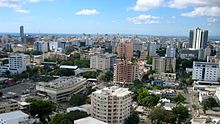Politics of the Dominican Republic
[citation needed] The Dominican Constitution takes twenty-seven paragraphs to spell out the president's extensive powers.Among the most important are those that grant him authority over virtually all appointments and removals of public officials, and even popular elected ones; empower him to promulgate the laws passed by Congress; direct him to engage in diplomatic relations; and empower him to command, to deploy, and to make appointments in, the armed forces.In order to become an attorney general, the individual must be meet the following requirements: Legislative power is exercised by a bicameral National Congress (Congreso de la República).The Judicial Power is charged of administering justice in order to ensure the respect, protection and supervision of rights recognized under the Constitution and laws.Its higher organ is the Supreme Court of Justice, which is composed of 16 judges appointed by the National Council of the Magistracy, an entity created by the constitutional reform of 1994 to ensure the independence of the Judicial Branch.The Dominican Republic has 31 provinces (provincias) and one National District* (Distrito Nacional): Azua, Baoruco, Barahona, Dajabón, Duarte, El Seibo, Elías Piña, Espaillat, Hato Mayor, Independencia, La Altagracia, La Romana, La Vega, María Trinidad Sánchez, Monseñor Nouel, Monte Cristi, Monte Plata, Pedernales, Peravia, Puerto Plata, Hermanas Mirabal, Samaná, Sánchez Ramírez, San Cristóbal, San José de Ocoa, San Juan, San Pedro de Macorís, Santiago, Santiago Rodríguez, Santo Domingo, Distrito Nacional, and Valverde.In the 1994 elections, international observers noted many irregularities in the voter lists, and the opposition PRD immediately charged the Central Electoral Board and the PRSC with fraud.By all estimates, total disenfranchised voters far exceeded the 22,281-vote margin of victory in favor of President Balaguer on 2 August 1994.The main candidates in 1996 were Vice President Jacinto Peynado (PRSC), José Francisco Peña Gómez (PRD), and Leonel Fernández (PLD).He helped enhance Dominican participation in hemispheric affairs, such as the Organization of American States and the follow-up to the Miami Summit.Mejia entered office on 16 August with four priorities: education reform, economic development, increased agricultural production, and poverty alleviation.On 16 May 2008, Leonel Fernández, running for the Dominican Liberation Party, garnered about 54% of the vote for a second consecutive term in office.The constitution was changed, and Medina won reelection by a wide margin against Luis Abinader of the Modern Revolutionary Party (PRM).MejíaIn the runup to the 2020 presidential elections, supporters of President Medina pushed for an additional change to the country's constitution to permit a third term.Following demonstrations outside the congress led by Leonel Fernandez himself, and subsequently pressure from the United States (notably through a public readout of a call from Secretary of State Mike Pompeo), president Medina announced on July 22, 2019, that he would not run again, calling instead for "new blood" (i.e., not supporting ex-president Fernandez).Medina supports former Minister of Public Works Gonzalo Castillo against Fernandez in primaries for the PLD nomination scheduled for October 6.After Trujillo's death, Juan Bosch, running on behalf of the PRD in 1963, became the first democratically elected official in the country's history.[5] According to the Party's official website, the PLD considers itself to be primarily centre-left, rejecting populism and neoliberalism.After many years of dictatorship or corrupt democracy, the regime is believed to have shown some legitimacy after the election in 1996, in which the longtime leader Balaguer lost power to Leonel Fernández.





ConstitutionConstitutional CourtCongress of the Dominican RepublicChamber of DeputiesPresident of the ChamberAlfredo PachecoSenatePresident of the SenatePresident of the Dominican RepublicLuis AbinaderVice President of the Dominican RepublicRaquel PeñaCabinetJudiciarySupreme Court of the Dominican RepublicNational Council of the MagistracyNational Judicial CollegeelectionsAdministrative divisionsProvincesGovernorsMunicipalitiesForeign relationsMinisterRoberto ÁlvarezDiplomatic missions ofin the Dominican RepublicPassportsVisa requirementsVisa policyDominican RepublicdemocracyExecutive powerLegislative powerNational CongressDominican Armed ForcesDominican CabinetDominican ConstitutionAttorney General of the Republic (Dominican Republic)bicameralupper houselower houseproportional representationSupreme Court of JusticeCourt of CassationBaorucoBarahonaDajabónDuarteEl SeiboElías PiñaEspaillatHato MayorIndependenciaLa AltagraciaLa RomanaLa VegaMaría Trinidad SánchezMonseñor NouelMonte CristiMonte PlataPedernalesPeraviaPuerto PlataHermanas MirabalSamanáSánchez RamírezSan CristóbalSan José de OcoaSan JuanSan Pedro de MacorísSantiagoSantiago RodríguezSanto DomingoDistrito NacionalValverdeNational DistrictValverde MaoChristian DemocraticJoaquín BalaguerJosé Francisco Peña GómezJuan BoschJacinto PeynadoLeonel FernándezHipólito Mejíaelected presidentDanilo Medinanarrowly won election as presidentMedina won reelectionModern Revolutionary PartyMike Pompeo2020 Dominican Republic general electionElections in the Dominican RepublicdictatorshipcorruptBalaguerrepresentative democracypresidenthead of stategovernmentstate of emergencysocialistconservativeliberalWorld BankAristidegreat powerHistoryCacicazgoColonial governorsDevastations of OsorioSlave tradeEra de FranciaSpanish reconquestEspaña BobaSpanish HaitiUnification of HispaniolaLa TrinitariaWar of IndependenceSpanish occupation 1861–1865Restoration WarU.S. occupation 1916–1924RafaelHéctor TrujilloParsley massacreDominican Civil War